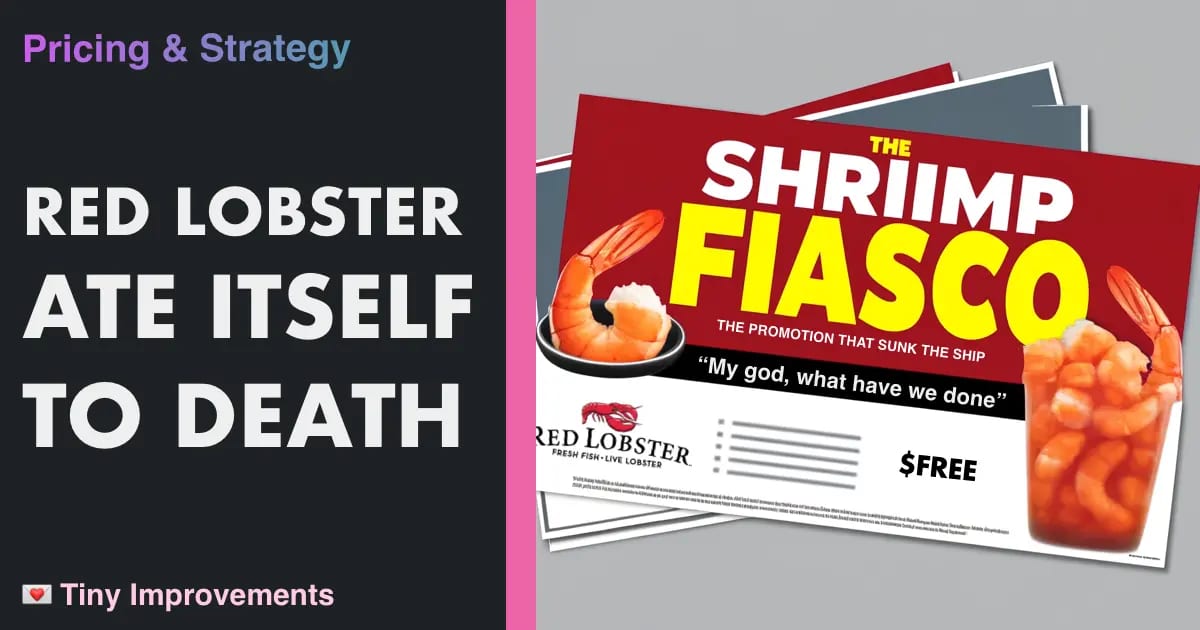- Home
- Newsletter
- Shrimps is Bugs: Red Lobster ate itself to death
Shrimps is Bugs: Red Lobster ate itself to death

Red lobster gave away so many free shrimp that they had to file for bankruptcy.
Believe it or not, this isn't a joke.
Red Lobster literally went bankrupt after making their $20 all-you-can-eat shrimp promotion a permanent menu item. Their customers ate them into failure - creating millions of dollars in losses... in shrimp.
So, friends:
if you're working on your business plan, try not to include an all-you-can-eat shrimp promotion in the mix.
That's it. That's the secret to business.
The numbers matter as much as the product
Okay, look - here's the thing: if you want to have a business that pays the bills, understanding the financial model behind your products is crucial.
I'd bet a whole stack of clams that there was at least one accountant at Red Lobster who was red in the face trying to explain to their leadership that a "giving away free shrimps" business model was going to be a disaster.
Promotions and giveaways can be powerful tools to attract customers, but they need to be carefully planned and executed with a clear understanding of their impact on your business.
There's also a point to be made about the value of giving away some services to early adopters to create hype and brand awareness. Promotions can certainly build buzz and loyalty, but as your product grows, you need to start getting paid to ensure sustainability and growth.
Generosity has its place, but it's essential to balance it with a sound financial strategy.
Start with the basics: P&L
Many developers (myself included) don't have a background in finance - and that's okay! But it's crucial to understand the basics of your business's financials. Here are a few key terms to get you started:
- Revenue: The money you make from selling your product or service.
- Cost of Goods Sold (COGS): The direct costs associated with producing your product or service.
- Gross Profit: Revenue minus COGS.
- Operating Expenses: The costs of running your business, like salaries, rent, and utilities.
- Net Profit: Gross profit minus operating expenses.
In developer terms, getting this right is about inputs and outputs: you're trying to build a machine that takes in more money than it costs to run.
Understanding these numbers will help you make informed decisions about your business and avoid making shellfish decisions that could sink your ship. (I'll stop.)
Document your expenses
When you're building a product, it's easy to get caught up in the excitement of development and forget about the costs. But documenting your expenses is crucial to understanding your financial health. Keep track of everything you spend, from hosting fees to marketing costs, and make sure you're accounting for them in your financial model.
You don't need to use a fancy tool to do this: a spreadsheet will work just fine. The key is to be diligent about tracking your expenses and updating your financial model regularly.
Understand your costs
Once you've documented your expenses, it's time to understand your costs. Calculate how much it costs to acquire a customer, including marketing and sales expenses. Then, match these against the price your customers pay. Determine how many months a customer needs to stay for you to break even and eventually make a profit.
Many developers who get into building products don't fully understand this, but it's crucial to go through this rigor. Even with a fast-growing product, overlooking these details can easily bury you in a failing business model.
If the math doesn't add up, it's time to reevaluate some combination of your pricing strategy, marketing efforts, and product features that drive costs up.
Your goal is to build a product that can pay for itself -- and much more, hopefully.
(also, shrimps is bugs. 🦐🦐🦐)
Ya gotta get paid
If you're building a product, you need to get paid for it. It's as simple as that.
- F*ck you, pay me is a classic talk from Mike Monteiro about the importance of getting paid for your work. It's a must-watch for anyone who's ever struggled to get clients to pay up.
- If you're an Indiehacker building a SaaS, this post on Indiehackers has lots of great wisdom: How to price your product
- If you're building a developer product, you may find my recent interview with the founder of Unkey interesting. We talked a bit about building API products with usage-based pricing, and how to make sure you're getting paid for the value you're providing.
I want to hear from you!
If you've got books, videos, podcasts, or articles to recommend for engineers who want to build a better business, send them my way. I'm all ears!




